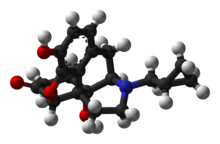Naltrexone
 |
|
 |
|
| Clinical data | |
|---|---|
| Trade names | Revia, Vivitrol |
| AHFS/Drugs.com | Monograph |
| MedlinePlus | a685041 |
| Pregnancy category |
|
| Routes of administration |
By mouth, intramuscular |
| ATC code | |
| Legal status | |
| Legal status | |
| Pharmacokinetic data | |
| Bioavailability | 5–40% |
| Protein binding | 21% |
| Metabolism | hepatic |
| Biological half-life | 4 h (naltrexone), 13 h (6β-naltrexol) |
| Excretion | Urine |
| Identifiers | |
|
|
| CAS Number | |
| PubChem CID | |
| IUPHAR/BPS | |
| DrugBank | |
| ChemSpider | |
| UNII | |
| KEGG | |
| ChEBI | |
| ChEMBL | |
| ECHA InfoCard | 100.036.939 |
| Chemical and physical data | |
| Formula | C20H23NO4 |
| Molar mass | 341.401 g/mol |
| 3D model (Jmol) | |
| Melting point | 169 °C (336 °F) |
|
|
|
|
|
|
|
Naltrexone is a medication that stops the activity of opioids. It is used primarily in the management of alcohol dependence and opioid dependence.
The closely related medication, methylnaltrexone, is used to treat opioid-induced constipation but does not treat addiction as it does not cross the blood brain barrier. Nalmefene is similar to naltrexone and is used for the same purposes as naltrexone. Naltrexone should not be confused with naloxone, which is used in emergency cases of opioid overdose.
Naltrexone is marketed under the trade name Revia and Vivitrol. In the United States as of 2016, naltrexone tablets cost about $0.91 per day. The extended-release injections cost about $1248.50 USD per month (41.62 USD per day). A combination of naltrexone with bupropion is used to treat obesity in the United States.
The main use of naltrexone is for the treatment of alcoholism. Naltrexone has been shown to decrease the amount and frequency of drinking. It does not appear to change the percentage of people drinking. Its overall benefit has been described as "modest".
Acamprosate may work better than naltrexone for eliminating drinking, while naltrexone may decrease the desire for alcohol to a greater extent.
The Sinclair method is a method of using opiate antagonists such as naltrexone to treat alcoholism. The patient takes the medication about an hour (and only then) before drinking to avoid side effects that arise from chronic use. The opioid blocks the positive reinforcement effects of alcohol and allows the person to stop or reduce drinking.
Naltrexone helps patients overcome opioid addiction by blocking the effects of opioid drugs. It has little effect on opioid cravings. Naltrexone has in general been better studied for alcoholism than in for opioids. It is more frequently used for alcoholism, despite its original approval by the FDA in 1984 for opioid addiction.
...
Wikipedia
